
Pavel Tsatsouline - Bullet Proof Abs (2nd Ed)
.pdf
H OW TO BR U TA L I Z E THE O BLIQUES AND SAVE Y OUR SPINE
Sit back on your heels, sticking your butt out and keeping your weight on your heels. (Fig. 85)
Fig. 85
Don't just go down. (Fig. 86) This shifts your weight forward on your toes making it impossible to use the strong hip muscles and putting unhealthy stress on your knees.
Fig. 86
Don’t just drop down!
81
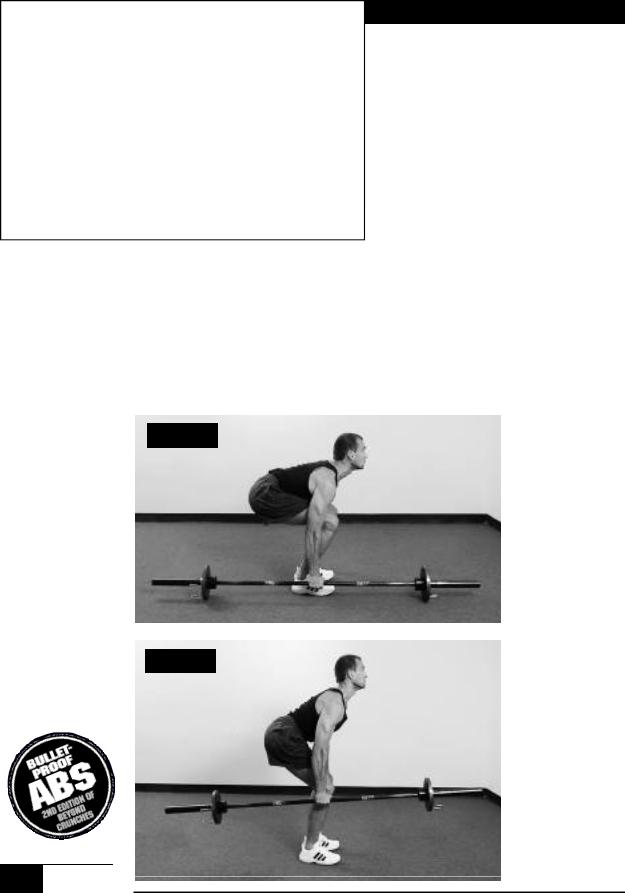
HOW TO B RUTALIZE THE OBLIQUES AND SAVE YOUR SPINE
Grab the bar very hard—crush it!—and push the floor away. That's right, don't pull on the bar, just push the floor away, as in a leg press. This is a neat visualization Olympic weightlifters use—to learn how to lift with their legs, rather than backs and arms.
Make sure that your arm is straight and tense when you start the lift, flex your triceps. Yanking on the barbell or curling does not help to lift much iron and could injure your arm or back. Consider the analogy of starting towing a car with a slack cable. Keep your back straight for the duration of the drill.
This exercise is not a side bend, and not a twist! Your body should raise evenly. (Fig. 87) It helps your balance to imagine that you lift a suitcase in each hand.(Fig. 88)
Semi-exhale as you reach the top. (Fig. 88) Do not lean back or sideways with the weight.
Fig. 87
Fig. 88
82
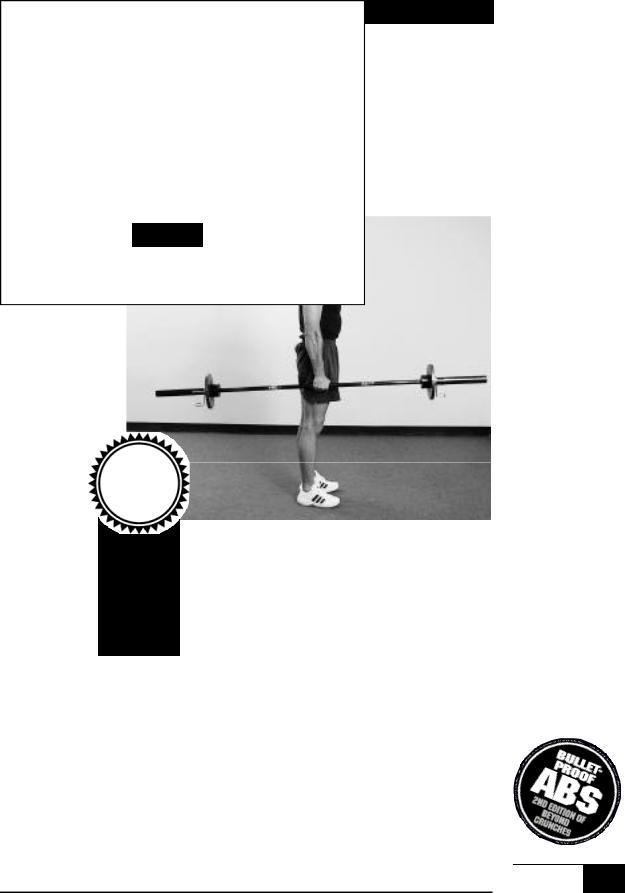
HOW TO BRUTALIZE THE O BLIQUES AND SAVE YOUR S PINE
Semi-exhale as you reach the top. (Fig. 89) Do not lean back or sideways with the weight.
Inhale and sit back. Don't think of lowering the bar. It will make your descent crooked and use too much back. Just sit back. The weight will take care of itself.
Fig. 89
Don’t
Lean back or sideways with the lift!
83
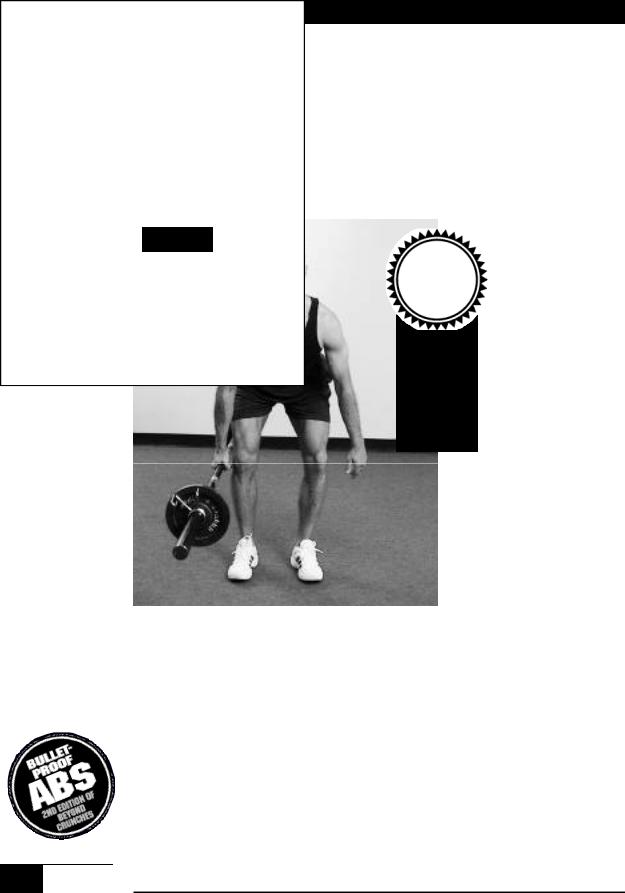
HOW TO B RUTALIZE THE OBLIQUES AND SAVE YOUR SPINE
It is hard to set the bar down in exactly the same spot as you had picked it up. (Fig. 90) The unintelligent piece of metal tends to land an inch or two in front of where it should be. Keep that in mind and make the necessary correction. Set it down a little further back than you should.
Fig. 90
Keep that arm straight and tense when you start
the lift!
84
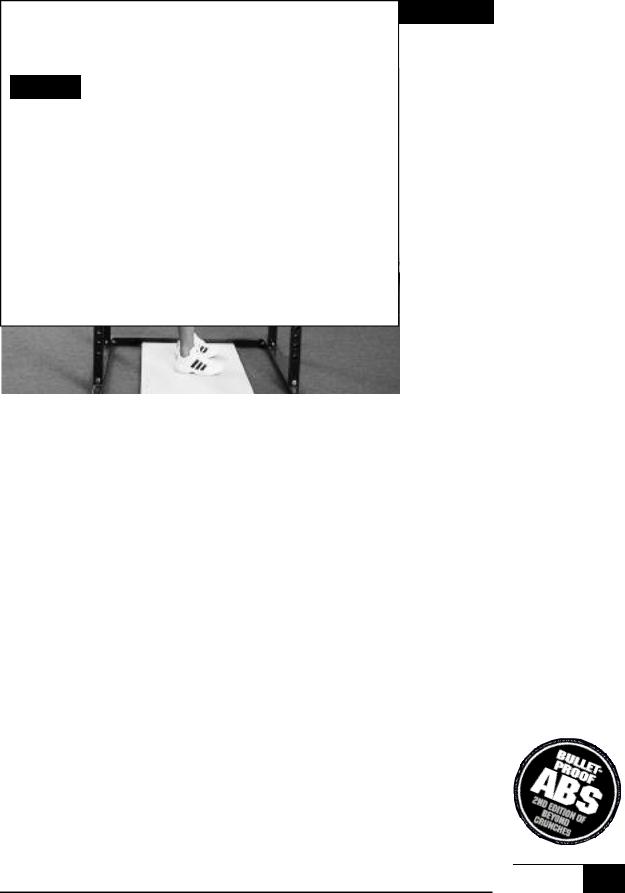
HOW TO BRUTALIZE THE O BLIQUES AND SAVE YOUR S PINE
Fig. 91
People with long torsos and short arms usually have difficulty picking up a weight off the floor in good form and should do most of their deadlifting in a power rack or off some sturdy blocks. (Fig. 91) Come to think of it, so do most Comrades unfamiliar with the One-Arm Deadlift.
The coolest way to incorporate power rack deadlifts in your schedule is neurological carryover. Start with the bar at your knee level and lower it an inch or so every third workout. If the space between the pin holes in your rack is more then two inches, stand on plywood to make smaller jumps. In the olden days lifters would dig a hole in the ground and deadlift while standing in it. They would lengthen the movement by adding an inch of dirt every few workouts. Eventually the hole would fill up and the strongman would pull a full deadlift with a weight he used to be able to budge only a few inches!
85
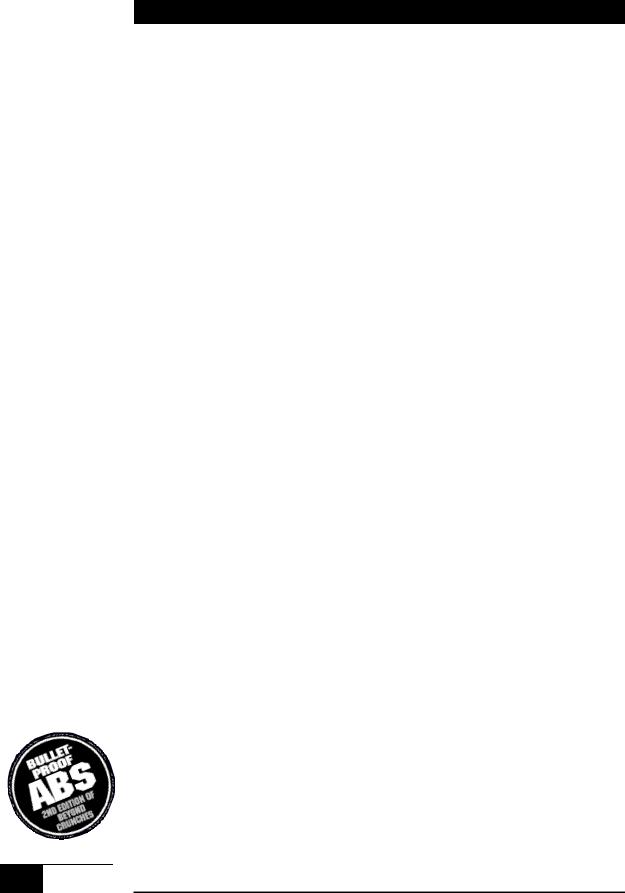
86
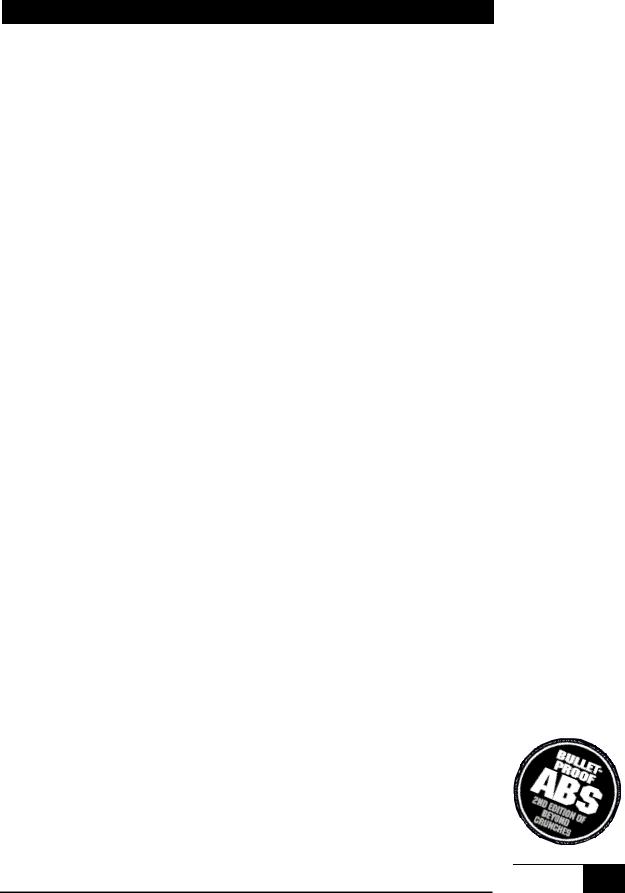
BOOST YOURSELF TO CHAMPION WITH POWER BR E AT H I N G
Part IV
How to Boost Yourself from Wannabe to Champion with Power Breathing
Warning! Many American physicians believe that holding your breath during exercise could be hazardous to your health. If you have a heart problem, high blood pressure, or other health concerns, consult your physician before attempting any of the breathing patterns described in this book!
While sports scientists from the former Soviet Union emphasize special exercises for the respiratory muscles and recommend state of the art breathing patterns to be employed during exertion, all the Western breathing wisdom can be summed up in "inhale as you go down, exhale as you go up". This advice got old around the days of the Boston Tea Party.
There are two types of exhalation which are worlds apart: active and passive. A pagan Russian berserker’s war scream or the grunt of a strongman bending a horse shoe are examples of the former. The sigh of relief you give out after a successful job interview is a latter. The profoundly different effects these
breathing patterns have on your physical performance are known in Russia as the pneumo-muscular reflex. This neurological phenomenon can be compared to the amplifier of your stereo where your brain is the CD player and your muscles are the speakers. Special baroreceptors in your abdominal and thoracic cavities register the internal pressure and adjust your muscular tension like the volume control knob. The higher is this pressure, the greater your strength and
vice versa.
The skill of picking the breathing pattern appropriate for the task at hand separates the great athlete from the also-ran. When I teach martial artists to do splits, I show them how to rid their muscles of tension with a ‘let go’ passive exhalation. It should be obvious that an attempt to duplicate this breathing pattern under heavy metal dooms you for weakness and injuries. By the same token, constricting your respiratory muscles as if you are deadlifting five wheels during a stretch will only lead to ripped muscles and the flexibility of a cadaver.
87

BOOST YOURSELF TO CHAMPION WITH P OWER BREATHING
Martial artists have possessed the knowledge of the pneumo-muscular reflex for centuries. They expressed it as ‘matching the breath with the force’.
A karate master synchronizing a board splintering strike with a blood curdling "K-i-a-i!" does exactly that. Sudden squeezing of the air by a powerful contraction of the respiratory muscles and the abdominals peaks the internal pressure at the moment of the impact. This maneuver dramatically increases the muscular tension, or force, for a fraction of a second. By the same token, fighters know that once the power breath is out, you are there for the taking and you had better get out of the way!
How does all this relate to ab training? First, use a breathing pattern that maximizes the intra-abdominal pressure: groan, scream, hiss, or just plain hold your breath. Second, maintain high IAP until the end of the rep or half rep. Do not expel all of your air too soon, or you will lose tightness and strength. A repetition of a strength drill lasts a lot longer than a punch.
Try to kiai your way out of a four hundred pound bench press, and the bar will collapse your sternum as surely as a karate chop! As you exhale forcefully, you will amplify your strength for a moment—only to become weak as a kitten once your bad breath is out. Run out of air too soon during a wheel jackknife—and your chiropractor might upgrade his Mercedes to this year’s model.
Which power breathing technique should you chose? Any of the above will do, as long as you have cleared it with your doctor. A 1977 Soviet study by Vorobyev determined that both holding one’s breath and groaning increase strength. Screaming is not bad either. According to the 1961 study by Ikai and Steinhaus, subjects who shouted during exertion got a respectable 12.2% strength boost!
88
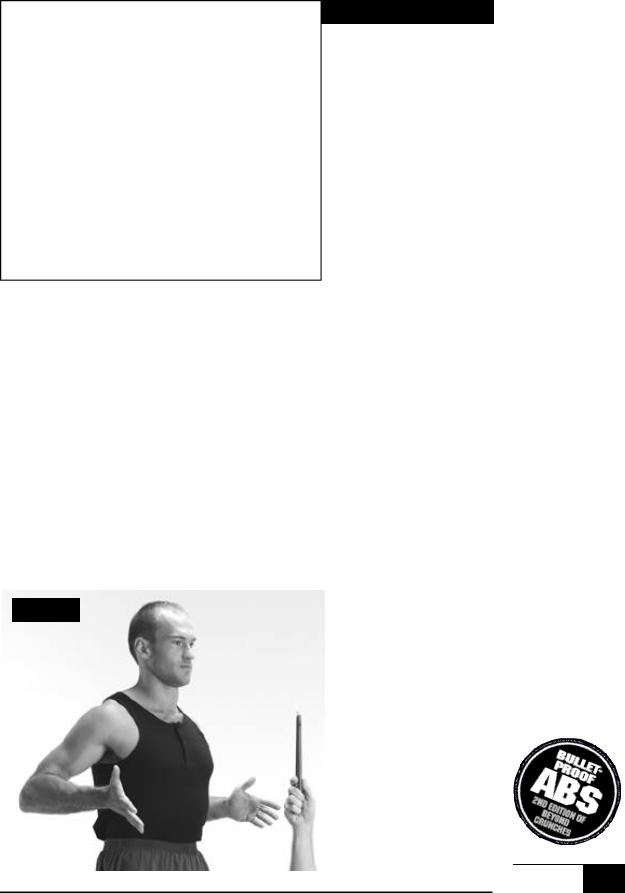
B OOST YOURSELF TO CHAMPION WITH POWER BR E AT H I N G
Bending the Fire
You will be able to squeeze even more juice out of either power breathing pattern if you practice the following drill recommended by Prof. Vladimir Zatsiorsky, a renegade Russian strength authority. This exercise is sometimes called in the martial arts circles ‘Bending the Fire’ because that is what your breath would do to the flame of a candle if you had one in front of you.
Take a normal breath—former weightlifting world champion Russian Prof. Arkady Vorobyev recommends 75% of your maximal air intake for peak strength performance —and flex your abs. At the same time contract your rectal sphincter as if you are trying to stop yourself from going to the bathroom. This bizarre maneuver from Iron Shirt Chi Kung further increases the inside pressure and amplifies your strength. The anal lock also acts as an insurance against hemorrhoids. Gym rats and couch potatoes alike tend to let their intestines go when they strain. Such a constipated style of strength training could lead to health problems and offers no performance advantage. Always pull up the muscles of the pelvic floor when you lift!
Expel the air forcefully in three to five seconds while keeping you glottis closed and your butt pulled in. It helps if you synchronize the expiration with arm movement. (Fig. 92-96) Push forward or downward to peak the contraction
of the midsection musculature. The Force is with you if you sound like Darth Vader.
Fig. 92
89
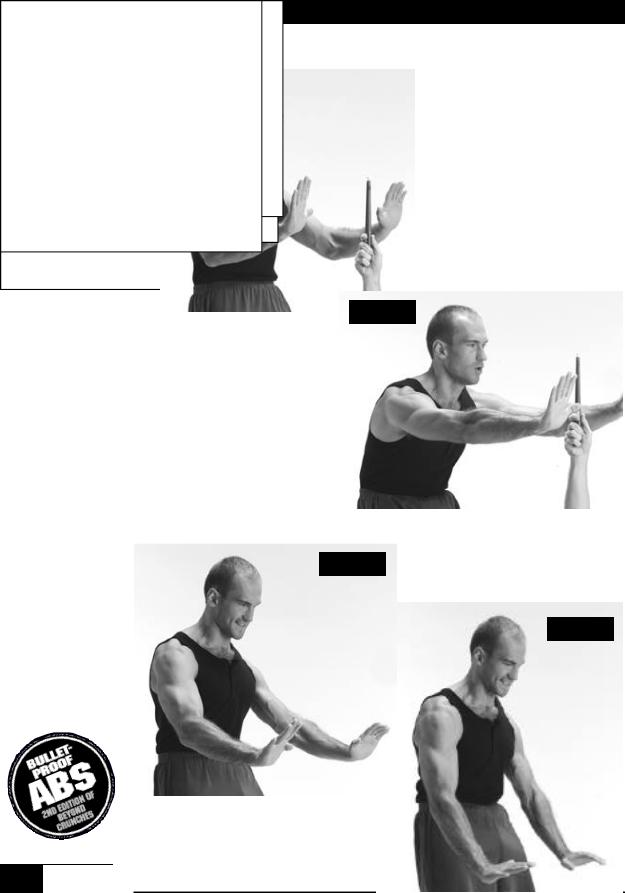
BOOST YOURSELF TO CHAMPION WITH P OWER BREATHING
Fig. 93
Fig. 94
Fig. 95
Fig. 96
90
